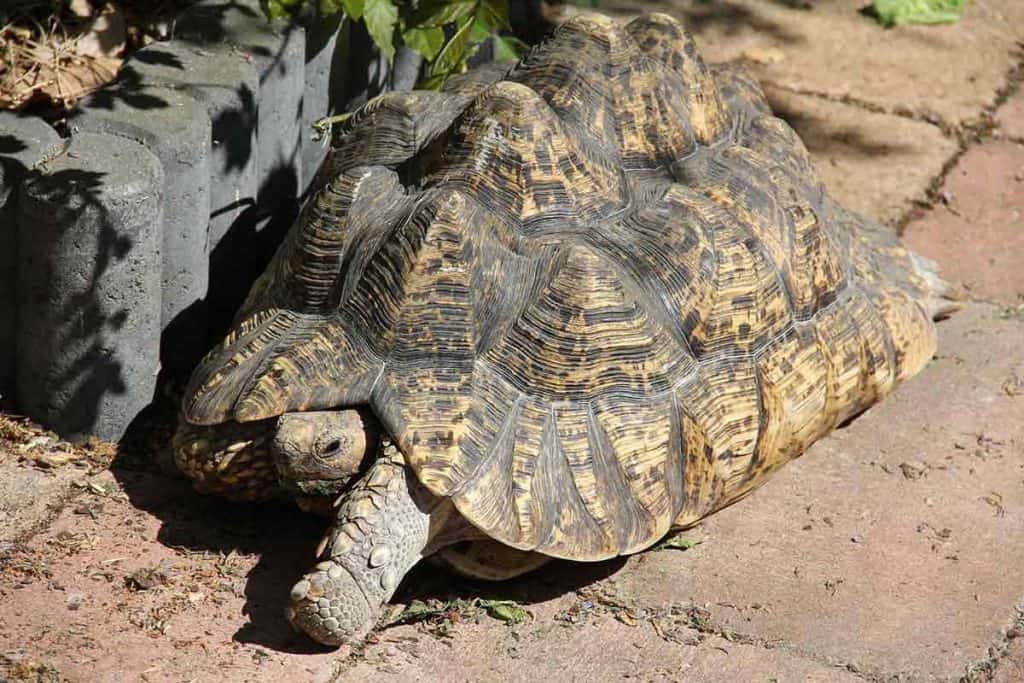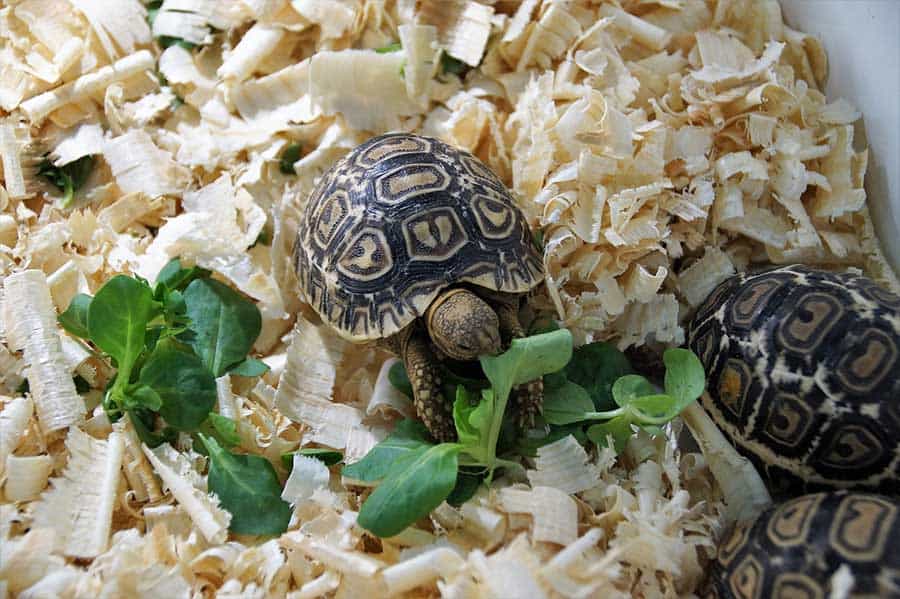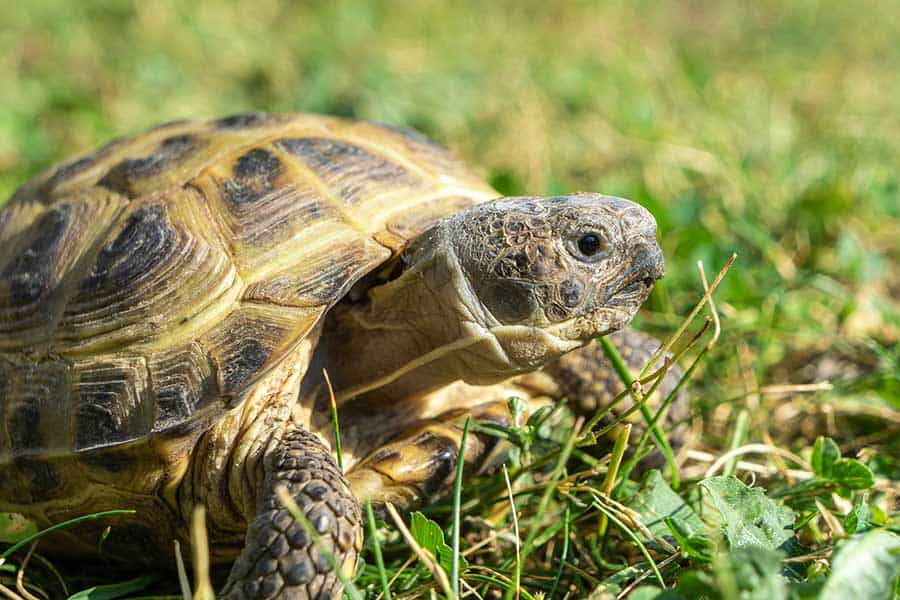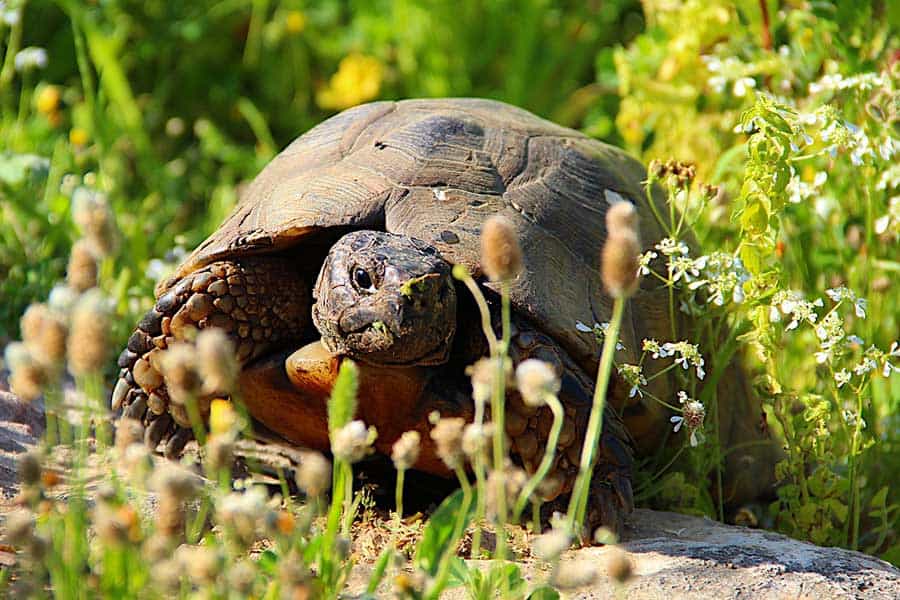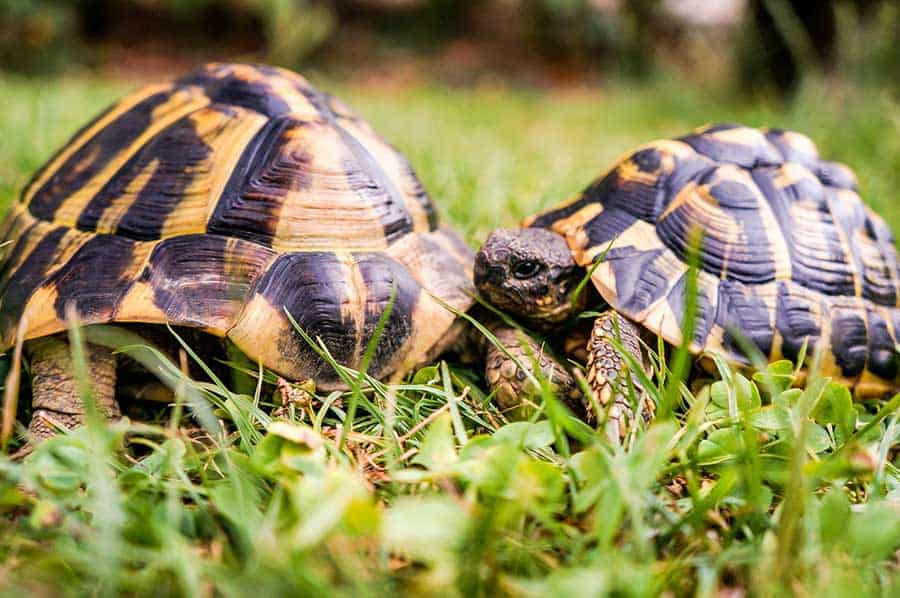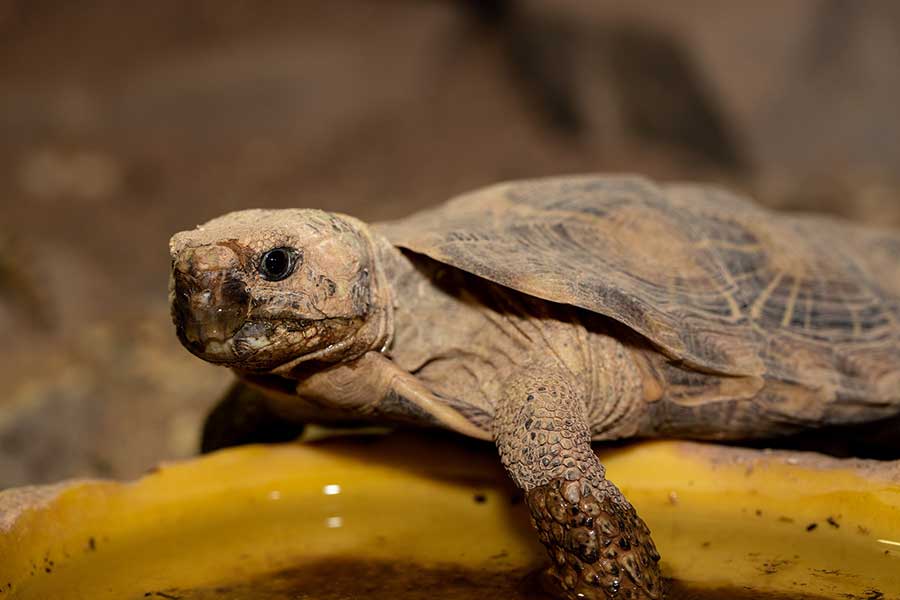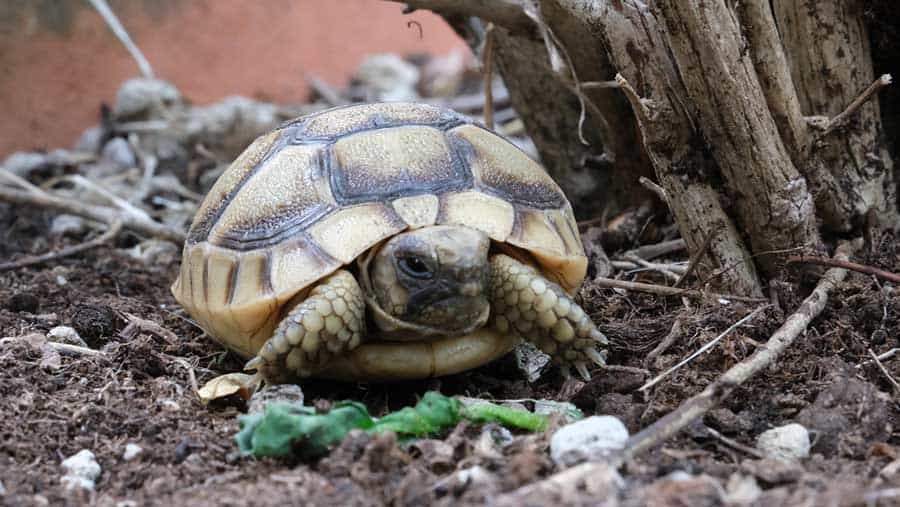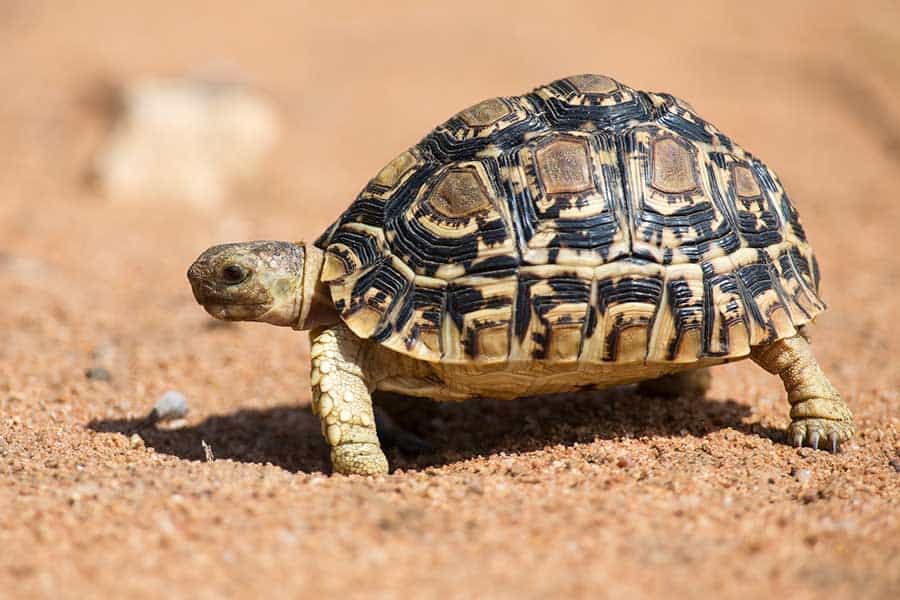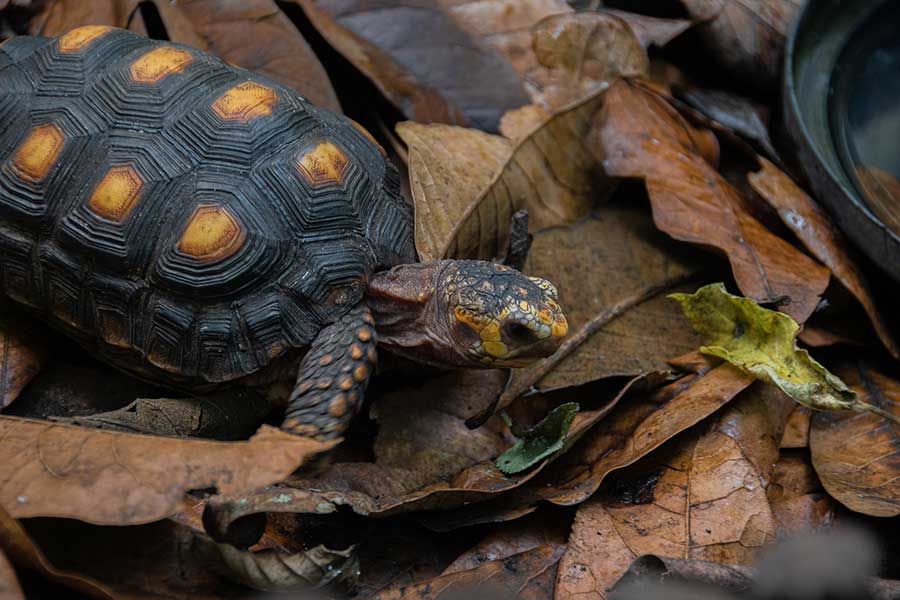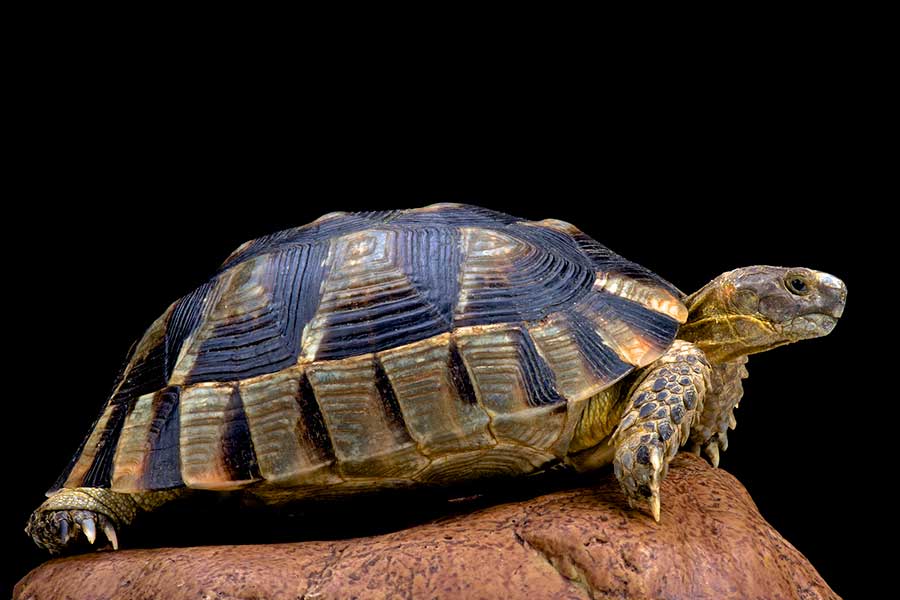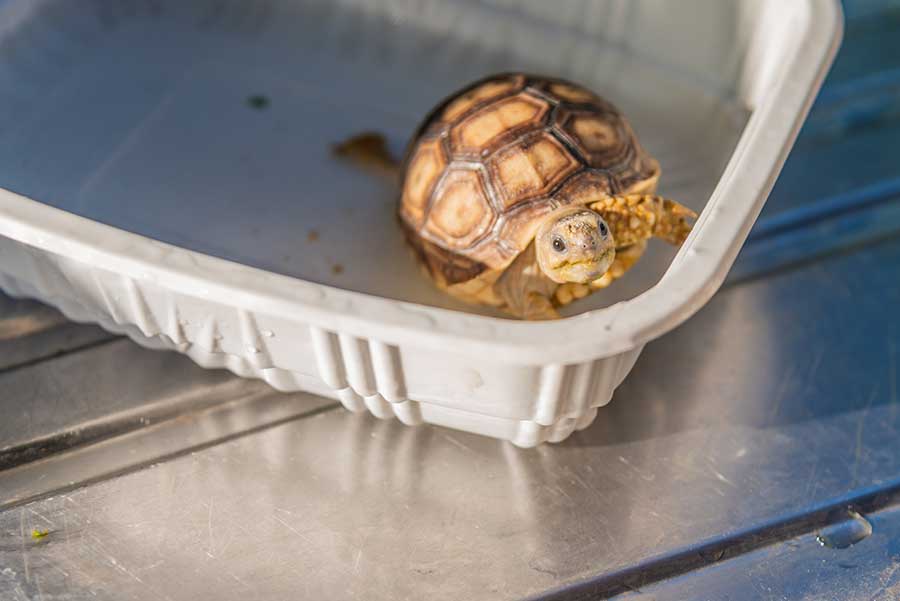There is plenty of information out there about caring for bearded dragons, geckos, monitor lizards, snakes, and all manner of furry and feathery friends. Unfortunately, there is little information on what makes the best pet tortoise and how you should choose the right species to fit in with your lifestyle.
In this guide, I will take you through the best 11 tortoise breeds you can own as a pet and what sort of homes and lifestyles they are best suited for.
Many species of tortoises make excellent pets because of their easygoing, hardy natures. They are also extremely long-lived, with life spans ranging anywhere from 30 years to over 100 years old!
You want to know what tortoise makes the best pet, so let’s get into it! We have divided the list of tortoises up by size, into small, medium, and large tortoises so you can find one that suits your living arrangements, preferences, and budget the best!
The Best Small Pet Tortoises
1. Indian Star Tortoise
The Indian star tortoise is a stunning pet to have. Their shell markings are unique and set them apart from other tortoises quite distinctly. Their shells are mostly dark brown with handsome tan or yellow star-shaped markings.
Notably, Indian star tortoises tend to be shyer and reserved than other breeds and should not be housed with other species of tortoises larger than they are, as this can cause severe stress to all animals involved. Once you establish a fixed routine and a proper housing setup, they will ‘come out of their shell’ a bit and become much more inquisitive.
However, housing Indian stars together can be done successfully, as they bond well with other members of their own species. They also don’t need to hibernate each year, meaning you will have an active little buddy the whole year ‘round!
Male Indian star tortoises reach five to six inches in length, while females of the species will usually reach seven to eight inches. The recommended enclosure size is at least three feet by two feet.
Indian stars come from the brushy forests in Sri Lanka, India, and Pakistan. This means they need plenty of hides and a suitable substrate that will allow them to hide anywhere in the enclosure for privacy.
Another important thing to note is this tortoise likes it hot. They need an enclosure that will range between 80°F and 90°F with a basking spot of 95°F. In addition to a hot enclosure, they also need 80% humidity to stay healthy.
This is an excellent breed to have if you are interested in creating a bioactive tortoise enclosure because natural plants will help maintain the humidity levels Indian stars need to thrive.
Keep in mind, however, they cannot be legally sourced from the wild. Ensure that you are getting your Indian star through a registered and responsible breeder.
2. Russian Tortoise
The Russian tortoise is an ideal candidate for beginners. They are readily available, fairly cheap, and bond with their owners almost instantly!
Unfortunately, these tortoises are so readily available because they are caught in the wild and sold in the illegal pet trade. If you buy a wild-caught tortoise, you run the risk of bringing home a sick, stressed, and parasite-ridden tortoise that may not live very long. You are also unwittingly supporting the illegal pet trade.
However, when you buy a Russian tortoise from local, responsible, and knowledgeable breeders, you can be sure that you will get a tortoise that is healthy and free of parasites. Russian tortoises that come from breeders in the US are also better adapted to the climate, whereas wild-caught ones need a period of adjustment.
The male Russian tortoise reaches five to six inches in length, while females reach six to seven inches in length. There is not a huge difference in size between the two sexes. Your Russian tortoise will need an enclosure that is at least three feet long by two feet wide.
These tortoises also do very well in family groups! If you have the space, get your tortoise a friend or two, or three, or four! They do especially well when they have an outdoor enclosure that gives them space to roam!
3. Greek (Mediterranean Spur-Thighed) Tortoise
Greek tortoises are very common amongst reptile hobbyists because they make excellent pets! This means you will be able to get your hands on a captive-bred one fairly easily and cheaply.
Unfortunately, they are also caught in the wild and sold in the illegal pet trade. These wild-caught tortoises will often be sick, very stressed, have high parasite loads, and may die on you even if you have done everything right when it comes to their care needs.
Male Greek tortoises generally reach four to six inches in length, and females usually reach five to eight inches. Their enclosure should be at least three feet wide by six feet long. However, if you are planning on housing more than one Greek tortoise together, you will need to add an extra foot of length and width to the enclosure.
Greek tortoises like it extra crispy in their enclosure and will require a basking spot of 95°F to 100°F! If you live in a very cold climate, you may want to look at a different tort!
4. Hermann’s Tortoise
Hermann’s tortoises are incredibly popular among both experienced and beginner tortoise owners alike. They are stunning to look at and have big personalities despite their small size! They are excitable, interesting to watch, and bond well with their owners.
Interestingly, there are eastern and western variations of the Hermann’s tortoise.
The eastern Hermann’s tortoise male will reach five to seven inches, while the female reaches eight to nine! These torts are quite flat in comparison to the western variety and have a limited color variety from straw to tan with dark brown bars and patches on the shells.
The western Hermann’s tortoise is far more vibrant by comparison. Their shells vary in color from yellow all the way to vivid orange! This is starkly contrasted with their black stripes and patches. They are a bit smaller than their eastern cousins, with males averaging at four to five inches and females reaching somewhere between five and six.
Regardless of whether you opt for the eastern or western variant, these tortoises should be housed in an enclosure that is at least three feet by four feet in size. They are small but very active and love to explore.
5. Pancake Tortoise
The pancake tortoise earns its name by having an unusually flat shell! These bizarre tortoises are well-loved amongst reptile owners but are hard to come by. Their numbers in the wild have been depleted by the illegal pet trade. This makes captive-bred specimens rare and expensive.
Even though they will cost you more, getting your pancake tortoise from a registered breeder means you will get a tortoise that has the best chance at living a long and healthy life.
Unlike other tortoises, their shell is slightly flexible! They use this adaptation to dive into rock crevices in the mountain regions where they live to escape airborne predators such as eagles.
They are also quite unusual compared to most other tortoise species because they can climb extremely well. This unfortunately means they are escape artists, especially if they feel their enclosure is too small or otherwise stressful for them. When putting the enclosure together, a secure and lockable lid is essential to avoid a runaway tortoise.
And run away they can! To add to the growing list of unusual abilities for this six-inch tortoise, pancake tortoises are pretty fast, which means you can lose yours if your enclosure is not secure.
6. Egyptian/Kleinmann’s/Leith’s Tortoise
Egyptian tortoises come from…you guessed it: Egypt! They are also found in Libya and Israel.
The Egyptian tortoise is, unfortunately, making its way onto the endangered species list, so be aware of how your purchase can affect wild populations. Only buy an Egyptian tortoise from a registered breeder.
Egyptian tortoises are incredibly small and therefore only need about four square feet of space to roam around in. An enclosure that is roughly two feet long and two feet wide is highly recommended.
If you live in an apartment, a flat, or a very cold region where keeping your tortoise outside is not an option, then this might be the one for you!
Males of the species only reach about four inches in length and weigh in at around 100 grams! Females are usually a bit bigger than males and grow to be about five inches long and 400 grams.
Because these tortoises are so small, the babies are incredibly vulnerable and delicate. This makes caring for them while they are young pretty difficult. However, you can speak to a breeder about getting one when it is slightly older if you have any doubts.
Egyptian tortoises are desert dwellers in the wild, so they need it pretty hot in captivity, too. They will need a temperature range of 75°F to 85°F with a basking spot of 90°F. Keep in mind that these high temperatures mean you can actually dehydrate and cook your tortoise without proper rehydration!
Egyptian tortoises love a good soak; however, you can also set up and maintain a humid hide for them to use at their leisure.
Beginners should avoid getting Egyptian tortoises. Due to the species’ small size, they can be tricky to take care of.
The Best Medium-Sized Pet Tortoises
If you have the space and want a slightly bigger tortoise, then have a look at some of these great species below! These tortoises tend to reach sizes of around 10 to 20 inches long.
7. Leopard Tortoise
Leopard tortoises come from all over Africa. They are stunning to look at, and this has made them a very popular species of pet tortoise amongst reptile owners.
These medium-sized tortoises range from 10 to 18 inches in size depending on what subspecies you get. This means you will need a big enclosure. The recommended minimum size for a leopard tortoise enclosure is 10 feet by 10 feet. Therefore, they will need to be housed outside unless you are willing to designate an entire (sizable) room for them.
Leopard tortoises do well in groups and are very social. However, for every tortoise you add to the group, you need to extend the size of their enclosure by a square foot.
Leopard tortoises are personable, curious, and very fun to watch. However, because they can get quite large, it means their care requirements are also a bit more complicated than smaller tortoises. They are more expensive to feed, house, and keep warm. Make sure you are up for the financial challenge before bringing one into your home (or yard)!
8. Red-Footed Tortoise
The red-footed tortoise is a great choice for a beginner. They are well-loved in the reptile community for their ease of care and their stunning coloration. These tortoises come from the Caribbean Islands and parts of South America.
As their name indicates, they have red feet, or more specifically, red spurs on their legs!
If you are looking for a tortoise that has a personality as fiery as its legs are, then this is the one for you. They are confident, curious, and rarely shy. Red-footed tortoises readily bond with their owners and enjoy the affection of a good scratching session.
Female red-foots average at around 11 to 14 inches in length with males being a bit smaller. Unfortunately, there are also records of nine-inch red foot females that are a direct result of farm breeding and poor breeding practices.
Finally, keep in mind that these medium-sized torts are diggers! So, in addition to the four feet by six feet enclosure, you will need to extend the enclosure’s barriers a bit below ground too (if they are outside) by at least five inches to avoid them tunneling their way out.
9. Marginated Tortoise
The marginated tortoise is one of the most emo-looking reptiles out there! Their bright colors as hatchlings fade to black and gray as they get older and the weight of existential angst bears down on them.
All jokes aside, these are stunning tortoises with interesting shell architecture. Towards the edge of the shell, the scutes flare out, creating a “swooped” look.
Marginated tortoise males average at 12 to 14 inches in length, and females are just a bit larger, reaching 13 to 15 inches in length. Their somewhat substantial size means they need an outdoor enclosure. They are climbers as well as diggers, so make sure the walls of the enclosure are at least 15 inches above the ground and extend for six inches below it.
These tortoises are easy to find in the pet trade, and they frequently live to be a whopping 100 years old! Be prepared for a very long relationship, and always remember to include them in your will!
If you are looking for a hardy, long-lived, odd-looking, medium-sized tortoise, then this is the one for you!
Large Types of Tortoise Pets
Overall, large tortoises are difficult to care for outside of zoos and professional wildlife preserves. Most species are extremely heavy, severely endangered, live to be well over 100 years old, and are so rare and expensive with almost no information on keeping them that the risk of them dying and their cost of care becoming too great for them to be a feasible pet.
Therefore, we have only listed one large tortoise in this section.
10. Sulcata (African Spur-Thighed) Tortoise
The sulcata tortoise comes from many places on the African continent. They are hardy animals that live in a variety of climates.
The average sulcata male will grow to be 20 to 25 inches in length. The average female can grow to 30 inches and weigh 100 pounds! These big guys need an entire backyard to move around in and will eat a lot every single day.
Unfortunately, many people do not realize how big sulcatas get and will give them away or surrender them once they pass the cute hatchling stage and start eating them out of house and home.
Before letting your sulcata loose in your yard, you will need to make sure that your walls are sturdy and at least 24 inches high. You will also need to reinforce underground to 24 inches deep because sulcatas can dig–a lot!
Although they grow to be absolutely massive pets, they are worth it for those up to the task. They are highly intelligent, curious, love to be petted, and bond well with their owners. If you are up to the financial commitment and have enough space and time, then this is an ideal tortoise regardless of your experience level.
Important Factors to Consider When Choosing Your Tortoise
Before considering what tortoise you want to own, you need to consider a few serious matters. Tortoises are not as common to own as snakes or lizards, and so many people do not know that there are specific needs that need to be met in your lifestyle and home before bringing your pet tortoise home.
Here are some questions you’ll need to ask yourself before adopting any kind of tortoise, no matter how large or small.
Does Your Location Fit Your Tortoise?
Tortoises generally come from very hot areas. This means they need plenty of sun and heat in captivity and will not do very well in cooler areas that receive snow and frost for most of the year.
If you live in a colder climate, to combat the issue of snow and frost, your tortoise will have to spend a lot more time inside than outside. Therefore, you will need to have lots of extra space and be committed to higher electricity costs as you will need to provide constant high heat to your tortoise’s enclosure through lamps and heat pads.
Can You Afford to Feed a Very Hungry Tortoise?
As a general rule, tortoises eat way more than you think they do, regardless of their size.
Tortoises are generally herbivorous and eat fresh vegetables and grains. They also need additional vitamins added to their diets as well as a
The cost of all of these things can add up pretty quickly. Before you purchase your tortoise, make sure you can afford to feed it properly. Diets can vary by species, so be sure to research the species of tortoise you’re interested in and what they eat before bringing them home.
Is It Legal to Own a Tortoise in Your State?
Tortoises fall under exotic pets. While you may be able to get away with owning a number of ball pythons or bearded dragons, your state may have specific laws on owning a tortoise.
It is important to check up on these laws before you purchase your tortoise. Sometimes, there are specific breeds that are illegal to own.
Check out your state’s laws regarding owning exotic species.
Do You Have Space in Your Home to Make Your Tortoise Happy?
Tortoises need a significant amount of space to roam around. They will need an enclosure such as a tortoise table that provides them with all of their humidity and temperature needs as well as a bath to soak in.
Your tortoise should also have access to a garden to roam about freely so that it can get some fresh air, real sunlight, and decent exercise. This is especially true for medium and large tortoises.
FAQs About Pet Tortoises
Is keeping a tortoise as a pet as easy as keeping a turtle as a pet?
Because they are usually semi-aquatic, pet turtles require a more sophisticated setup than strictly land-dwelling tortoises. They need access to water, and the water needs to be at the correct temperature, have the proper amount of salinity, and must be constantly pumped and filtered. A lot can go wrong with this setup and cause your turtle to develop fatal health issues.
Therefore, tortoises are generally easier to care for than turtles.
What is the friendliest type of tortoise to have as a pet?
Most tortoise breeds are equally friendly and shy. Each tortoise will have its own personality and it is generally one of a gentle yet curious giant.
Do tortoises make good indoor pets?
Most tortoises, especially larger species, do not make good indoor pets. They thrive on fresh air and lots of sunshine. Keeping one constantly cooped up inside the house is not recommended and can even lead to them having a shortened lifespan due to stress.
If you want a good indoor pet, have a look at our lists of the best pet lizards, the best pet geckos, and the best small pet snakes!
What is the easiest tortoise to care for?
The Greek (Mediterranean spur-thighed) tortoises are probably the easiest pet tortoises to care for because they are forgiving to beginner mistakes.
What is the best tortoise for beginners?
Most of the tortoises on this list would make good beginner pets. Sulcata tortoises are especially hardy once they have gone through the delicate hatchling phase.
Keeping the smaller species of tortoises as pets is more difficult because they are more susceptible to damage caused by incorrect husbandry practices.
Slowly Strolling Off…
This list includes the best pet tortoises out there. Some breeds are more difficult to get your hands on legally, while others are being given away when they get too big for their owners to handle.
It is important to remember that tortoises are a long-term commitment, with most of them living between 50 and 100 years. This means that, depending on the species, your tortoise could see the birth of your great, great-grandchildren! Before diving into owning one, make sure you are up for the challenge.

